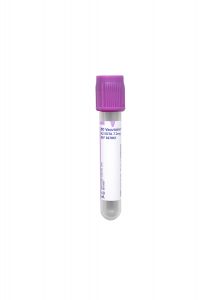CPT Codes
81218
Methodology
Next-Generation Sequencing
Turnaround Time
10 days
Specimen Requirements

Type:
Blood, whole
Volume:
4 mL
Minimum Volume:
2 mL
Specimen Container:
Lavender BD Hemogard™ K2EDTA Tube

Stability
Ambient:
48 hours
Refrigerated:
7 days
Frozen:
Unacceptable
Reference Range
CEBPA mutations are not detected.
Additional Information
Background Information
Mutations in the CEBPA gene are identified in 15-18% of acute myeloid leukemia (AML) with normal cytogenetics, and acute myeloid leukemia with mutated CEBPA represents a provisional diagnostic entity in the 2008 WHO classification.[1]
Acute myeloid leukemia with mutated CEBPA displays distinct clinicopathologic features including a favorable clinical course, and the identification of CEBPA mutations may assist in treatment selection.[2-6] CEBPA mutation analysis is recommended for cases of acute myeloid leukemia with normal cytogenetics in the current National Comprehensive Cancer Network (NCCN) and European LeukemiaNet guidelines.
Clinical Indications
Cleveland Clinic Laboratories offers CEBPA mutation analysis for classification and prognostic assessment of new acute myeloid leukemias, especially those with normal cytogenetics. Concurrent NPM1 and FLT3 studies are also recommended.
Interpretation
Mutations in CEBPA include single and dual (usually biallelic) mutations. Initial studies reported that the presence of any CEBPA mutation was associated with a favorable clinical course, while more recent studies have suggested that the favorable clinical course and distinctive clinicopathologic features are limited to acute myeloid leukemia with dual CEBPA mutations.[2-6]
All identified mutations are reported. Cases are classified as wild type (no mutations detected), single mutated, or dual mutated.
Limitations
Sanger sequencing is expected to identify >99% of mutations, provided that mutations represent at least 15-20% of total CEBPA alleles.
This test is not intended for the detection of minimal residual disease.
References
1. Arber DA et al. (2008). Acute myeloid leukaemia with recurrent genetic abnormalities. In: Swerdlow SH, Campo E, Harris NL et al., eds. WHO Classification of Tumours of Haematopoietic and Lymphoid Tissues. 4th ed. Lyon, France: WHO Press. 110-23.
2. Taskesen E, Bullinger L, Corbacioglu A, et al. Prognostic impact, concurrent genetic mutations and gene expression features of AML with CEBPA mutations in a cohort of 1182 cytogenetically normal AML patients: further evidence for CEBPA double mutant AML as a distinctive disease entity. Blood. 2011;117:2469-2475.
3. Green CL, Koo KK, Hills RK, et al. Prognostic significance of CEBPA mutations in a large cohort of younger adult patients with acute myeloid leukemia: impact of double CEBPA mutations and the interaction with FLT3 and NPM1 mutations. J Clin Oncol. 2010;28:2739-47.
4. Dufour A, Schneider F, Metzeler KH, et al. Acute myeloid leukemia with biallelic CEBPA gene mutations and normal karyotype represents a distinct genetic entity associated with a favorable clinical outcome. J Clin Oncol. 2010;28:570-7.
5. Pabst T, Eyholzer M, Fos J, et al. Heterogeneity within AML with CEBPA mutations: only CEBPA double mutations, but not single CEBPA mutations are associated with favorable prognosis. Br J Cancer. 2009;100:1343-6.
6. Wouters BJ, Lowenberg B, Erpelinck-Verschueren CA, et al. Double CEBPA mutations, but not single CEBPA mutations, define a subgroup of acute myeloid leukemia with a distinctive gene expression profile that is uniquely associated with a favorable outcome. Blood. 2009;113:3088-91.
